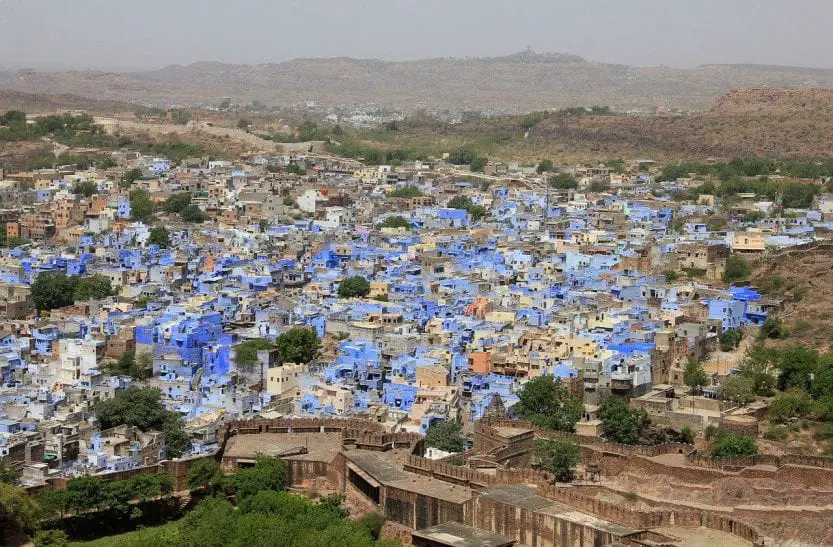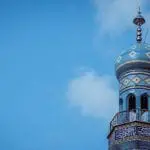A sobriquet is a familiar or a descriptive name given to people and places. Cities have sobriquets like Pink City, Blue City, etc. The sobriquet blue city is given to the city of Jodhpur in India. When you look at the city from the top, you can see many blue objects all over the city. This makes the city look blue whether you see it under in a bright morning or at night. The city is presented to tourists and visitors as the blue city. This makes visitors curious to see and explore this historic city.
About Jodhpur
Jodhpur is a city located in the northwest of India in the state of Rajasthan. It is the second-largest city in the state. It is one of the popular tourist destinations in the state. The state of Rajasthan is famous for the Thar Desert with large swathes of desert land full of sand. The state is well known for its forts and palaces, which is why it is a popular destination for visitors to India. This tradition can be found even in Jodhpur, which has palaces and forts with the Thar desert outside.
Historically, Jodhpur was part of the Marwar Kingdom. Jodhpur city was found in the year 1459 by a Rajput (one of the well-known warrior clans) chieftain Rao Jodha. The city is named after him. The Mughal Emperor Akbar conquered the kingdom and added it to his empire. Jodhpur prospered both under the Mughal rule and British rule. Once India became independent, the then ruler wanted to be independent but was persuaded to join the Indian Union.
Jodhpur has a population of 1,033,918. It is a metropolitan city and spans 90.2 square miles. Tourism is one of the main revenue earners for the city. People come to see the blue objects located all over this blue city. Some of the top tourist spots in the city are:
- Umaid Bhawan Palace
- Clock Tower
- Rao Jodha Desert Rock Park
- Mehrangarh Fort
- Jaswant Thada memorial
Jodhpur has a hot climate since it is in the desert. The best time to visit the city is from October to February when the climate is pleasant.
The Blue City
When you visit the Mehrangarh Fort and get an overview of the city, you will see blue objects everywhere. Most of them are houses that have been painted blue giving you a blue and beautiful view of the city. Like most old cities, the city has an old district and a new district. The old district has many historic buildings and homes that were built many years ago. This district is located in the north of the city. Here, you will find virtually all the buildings painted blue.
The plethora of blue objects that you can see from an aerial view is because buildings, houses, commercial properties, and government offices have all been painted blue. The blue color used is a light shade of blue that makes it look pleasant. It is not too dark and garish but is the color of a clear sky. It is because of the blue painted buildings that Jodhpur is referred to as the blue city. However, the question is why are the buildings painted blue?
Why is the city painted blue?
Jodhpur is known as the blue city because of the blue painted buildings. The interesting thing is that there is no specific or defined reason the buildings are painted blue. When you explore the city and talk to locals, you will find them giving different reasons why they prefer blue objects. Historians and architects will give a different perspective on the concept of the blue city. The following is a summary of explanations as to why Jodhpur is known as the blue city.
- Many locals say that the blue color is a light color chosen deliberately to shade the buildings from the harsh desert sun. They say that blue reflect the sun rays from the building. This keeps the building cool and does not allow it to heat up. Blue is not the only light color and this is not the right explanation but is a common belief among the locals.
- Historians will tell you that termites have plagued the city for many years. This is because of the dry desert environment that allows them to flourish. The termites started damaging the building exteriors. When the damage to buildings became extensive, city planners looked for a better solution. It was observed that adding a copper solution to the limewash (whitewash) helped to repel termites. This solution (copper sulfate and lime) created a blue color on the exteriors of houses. Later on, people started continuing this tradition and used blue paint.
- Hindus, who form the major population in the city and the state, worship the God Shiva. The color blue is associated with Lord Shiva since he swallowed poison to save the world. This is why his body became blue. Some historians say that the blue color is to show respect to the Lord who saved the world.
- Another explanation is related to the caste system in India. There are four major castes in the social hierarchy with the Brahmins being at the top. Some people believe that the Brahmins deliberately painted their homes blue so that it can be easily identified. This is a common theory that people state. However, the reality is that even people of other castes occupy houses that are painted blue.
- Some say that only Brahmins had the money to get the blue solution to paint the house blue. This is not entirely true since even traders are the richest people and belong to other castes.
There are various reasons why people have painted building blue in Jodhpur. Whatever may be the reason, the fact is that this has made the city famous. The preponderance of blue objects or blue houses makes this the blue city. This had made the city a popular tourist spot. If you haven’t visited this city, you can drop in to see for yourself why it is called the blue city.




